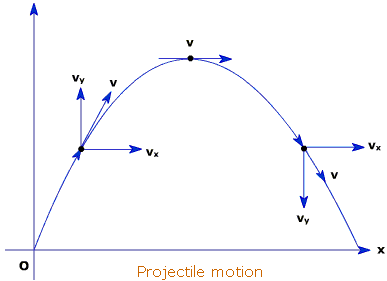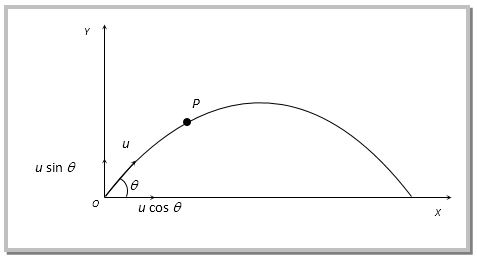A projectile is shot from the ground at an angle of #( pi)/3 # and a speed of #15 m/s#. Factoring in both horizontal and vertical movement, what will the projectile's distance from the starting point be when it reaches its maximum height?
3 Answers
I got
We assume or know:
- Horizontal acceleration is
#veca_x = 0# , since the projectile is let go after its launch (free horizontal motion). - Starting position is
#vecx_i = 0, vecy_i = 0# , on the ground.
Defining up as positive and right as positive, the coordinates along the parabolic arc are given by the system of equations, assuming no air resistance:
#vecy_f = 1/2vecg t^2 + vecv_(iy)t + cancel(vecy_i)^(0)#
#vecx_f = cancel(1/2veca_x t^2)^(0) + vecv_(ix)t + cancel(vecx_i)^(0)#

The "distance from the starting point" is
#vecd = sqrt((Deltavecx)^2 + (Deltavecy)^2)# .#" "" "bb((1))#
After our assumptions, here is what we don't know in red:
#color(red)(vecy_f) = 1/2vecg t^2 + vecv_(iy)t# #" "" "bb((2))#
#color(red)(vecx_f) = vecv_(ix)t# #" "" "" "" "" "bb((3))#
We can find
#vecv_(ix) = "15 m/s" cdot cos(pi/3) = "7.5 m/s"#
#vecv_(iy) = "15 m/s" cdot sin(pi/3) = 7.5sqrt3# #"m/s"# #~~# #"12.99 m/s"#
Recall from Calculus that taking the first derivative of
So, the time
#(dvecy_f)/(dt) = vecv_(fy) = 0 = vecg t + vecv_(iy)#
#=> t^"*" = -(vecv_(iy))/(vecg) = -("12.99 m/s")/(-"9.81 m/s"^2) = "1.32 s"#
As a result, the final
#color(blue)(vecx_f) = vecv_(ix)t^"*"#
#= "7.5 m/s" cdot "1.32 s"#
#=# #color(blue)("9.93 m")#
From
#color(blue)(vecy_f) = 1/2(-"9.81 m/s"^2)("1.32 s")^2 + (7.5sqrt3 " m/s")("1.32 s")#
#=# #color(blue)("8.60 m")#
Therefore, the diagonal distance traveled at max height is from
#color(blue)(vecd) = sqrt((Deltavecx)^2 + (Deltavecy)^2)#
#-= sqrt(vecx_f^2 + vecy_f^2)#
#= sqrt(("9.93 m")^2 + ("8.60 m")^2)#
#~~# #color(blue)("13.14 m")#
distance =
Explanation:
For Physics or Mechanics you should learn the "suvat" equations for motion under constant acceleration:
#{: (v=u+at, " where ", s="displacement "(m)), (s=ut+1/2at^2, , u="initial speed "(ms^-1)), (s=1/2(u+v)t, , v="final speed "(ms^-1)), (v^2=u^2+2as, , a="acceleration "(ms^-2)), (s=vt-1/2at^2, , t="time "(s)) :} #

Horizontal Motion
The projectile will move under constant speed (NB we can still use "suvat" equation with a=0).
The projectile will travel a distance
# { (s=,x,m),(u=,15 cos (pi/3)=15/2,ms^-1),(v=,"Not Required",ms^-1),(a=,0,ms^-2),(T=,t,s) :} #
So applying
# x = 15/2T#
Vertical Motion
The projectile travels under constant acceleration due to gravity. Its speed will be instantaneous
# { (s=,y,m),(u=,15 sin (pi/3)=(15sqrt(3))/2,ms^-1),(v=,0,ms^-1),(a=,-g,ms^-2),(t=,T,s) :} #
Applying
# 0=(15sqrt(3))/2-gT => T=(15sqrt(3))/(2g) #
Applying
# y=1/2( (15sqrt(3))/2 + 0) * (15sqrt(3))/(2g) = 675/(8g) #
From which we get:
# x = 15/2 * (15sqrt(3))/(2g) = (225sqrt(3))/(4g)#
Thus we can conclude that the point on the trajectory corresponding to the maximum height occurs at a horizontal distance of
So we calculate the distance,
# d = sqrt(x^2+y^2) #
# \ \ = sqrt(((225sqrt(3))/(4g))^2+(675/(8g))^2) #
Taking
# d = 13.1515 ... #
13.13 m
Explanation:
The expression for horizontal range d is :
Since we are interested in the horizontal distance when the projectile is at its maximum height we can say that, due to the symmetrical flight path, the horizontal displacement will be half this:
Horizontal displacement = 19.86/2 =
To get the height reached we can use:
Taking the vertical component of the motion this becomes:
To get the actual distance D from the starting point we use Pythagoras:



